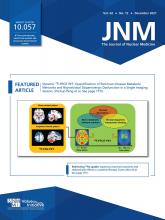TO THE EDITOR: I just read the article written by Polley and Dignam (1) titled, “Statistical Considerations in the Evaluation of Continuous Biomarkers.” In that article, the authors described some common statistical issues related to biomarker cut point identification and provided guidance on proper evaluation, interpretation, and validation of such points.
The article brings various statistical aspects that have to be considered when cut points are defined. However, in my opinion, it is important to clarify some other aspects when we talk about cut points—features that are missing from that article.
First, it is key to explain that biomarkers have distinct applications, such as screening, diagnosis, and prognosis, among many others (2). In this line of reasoning, the tools used to establish cut points vary in the dependence of the application. For instance, when a biomarker is used for prognosis, the percentiles and the minimal P value are possible methods to be used to establish cut points to define groups of individuals with distinct outcomes (3). However, when a biomarker is used for diagnosis, the classic tool to establish cut points is the receiver-operating-characteristic curve (4). In this sense, as specified by Polley and Dignam, we should not use receiver-operating-characteristic curves to define cut points when the biomarkers are used for prognosis since this methodology does not usually take into account the time to the event.
Second, it is necessary to know the characteristics of the biomarker before trying to establish cut points. The authors gave the example of the neutrophil-to-lymphocyte ratio, and it is clear that this parameter has a range of normal values with a lower and an upper boundary of normality. Therefore, it does not make sense to try to find a unique cut point to classify a biomarker of this kind. In this situation, it will be necessary to have at least 2 cut points to divide the values of the biomarker into groups of prognosis or diagnosis (5).
Third, the discretization process of a continuous biomarker is not necessarily dichotomous, even for cases in which there is a monotonic relation between the biomarker and the events of interest, and the values of the biomarker can be classified in several groups for either prognosis or diagnosis. In this line of reasoning, for prognostic purposes the percentile analysis can be used with different strategies, such as comparison of survival of individuals with values below a specific percentile to individuals with values above this percentile (dichotomous classification) (6) and comparison of more than 2 groups (7). In this aspect, the minimal-P-value approach has the drawback of not enabling separation of the individuals into more than 2 groups of outcome. For diagnostic purposes, it is also possible to establish more than one cut point to classify the individual by creating intermediate categories between positive and negative results (8). Although this increment in the number of categories does not solve the problem of the abrupt transition among them, at least it decreases the differences in the meaning between 2 neighboring categories. Therefore, the definition of the number of categories to divide a biomarker is an aspect as important as the definition of the cut points to be used to separate these categories.
Last, we should not evaluate the methodology used in a research study whose main objective is to assess the association of the biomarker with aspects of interest (prognosis, diagnosis, screening, and so forth) using exclusively the rigorous standards of the application of the biomarker in the clinical practice, with the risk of diminishing the importance of the research.
Footnotes
Published online September 2, 2021.
- © 2021 by the Society of Nuclear Medicine and Molecular Imaging.
REFERENCES
- Revision received July 13, 2021.
- Accepted for publication July 21, 2021.







